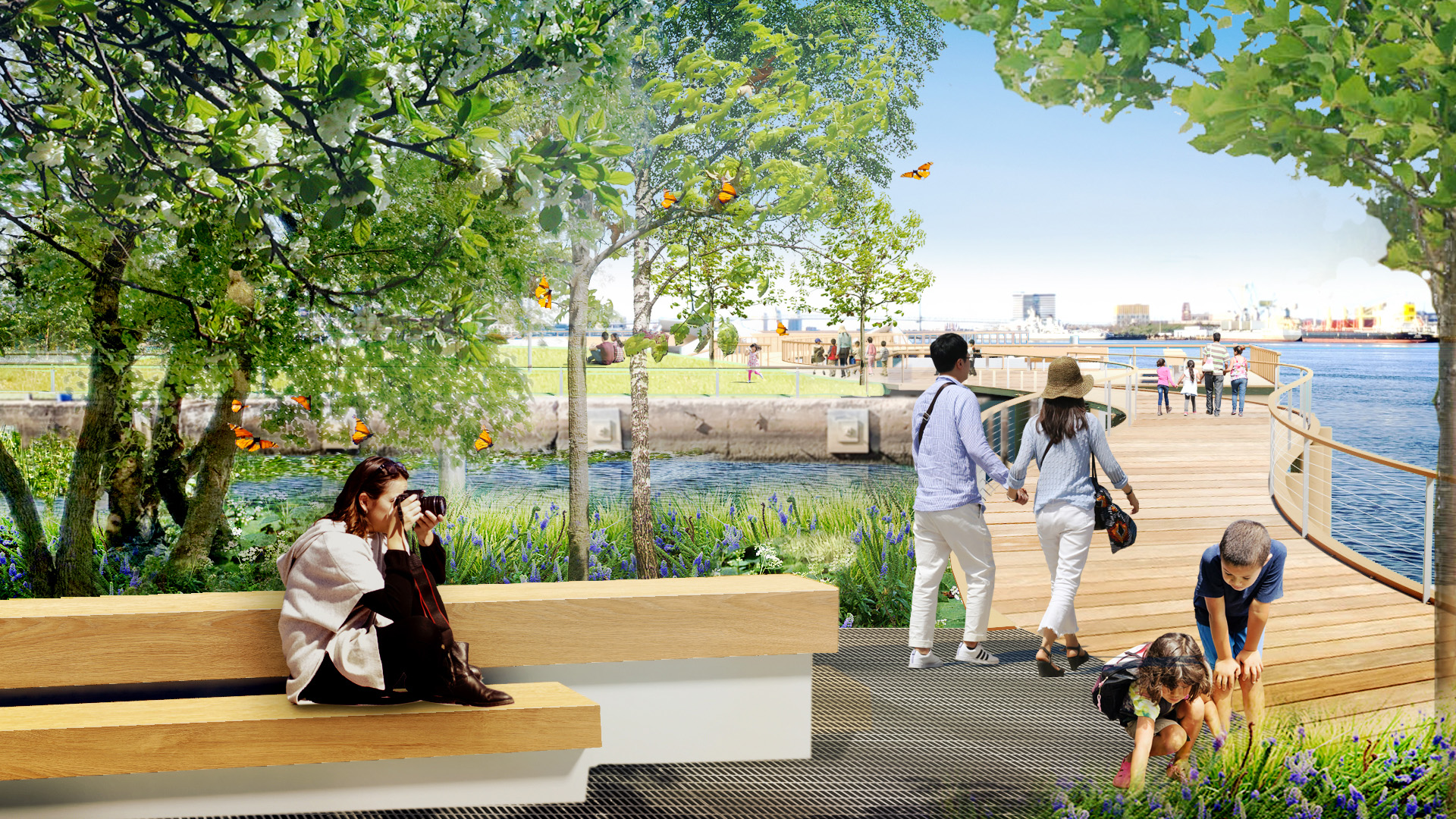
The South Wetlands Park project encompasses Philadelphia’s piers 64, 67, 68, and 70, roughly between Tasker Street and Pier 70 Boulevard. A former industrial site, the area now includes various retail stores and restaurants. Although Pier 68 was converted into a popular fishing pier in 2015, the other three piers are in various stages of decay and collapse. The park project plans to reuse what portions of the piers can be safely restored and link the piers with an elevated, curving boardwalk that will, in places, be supported on the piers’ original timber piles, explains Michael Miller, an associate at OLIN, a landscape architecture firm with offices in Philadelphia and Los Angeles. Unusable sections of the piers will be demolished. Material from the original piers might also be reused on the new park structures — for example to build a large, stepped seating element on Pier 67, explains an executive summary of the project by OLIN and the DRWC.

Abandoned structures
OLIN is leading the design of the wetlands park project, which is an outgrowth of the DRWC’s 2012 “Master Plan for the Central Delaware,” says Miller.
Woodcliff Lake, New Jersey-based McLaren Engineering Group provided structural evaluations of the existing piers, using underwater inspections, and conducted studies on the effects that sea level rise, high tides, and coastal wave action will have on the piers over the coming decades as well as the potential impacts of major storm events.

Piers 64, 67, and 70 are primarily wooden structures with steel and concrete sections that date to the early 20th century. But as the factories in the region shut down over time, the piers were largely abandoned, notes Todd Manson, P.E., M.ASCE, a senior associate at McLaren and the firm’s lead coastal engineer. Located close to the water surface, the piers are topped by soil and over the years have become heavily vegetated with trees and other plants. In some cases, Miller adds, the tree roots are the only things holding the piers together.
Diving for data
McLaren examined the structures using divers with surface-supplied air and studied the potential of sea level rise, wave action, and other factors by studying historical data from existing gauges in the Delaware River, considering reports and projections on the expected impacts from climate change in the region, says Manson.
The project team studied the effects of high tides on the piers today and over the next 45-60 years. It also considered the effects of a 100-year storm event and a 500-year storm event as well as a 100-year storm event happening 60 years from now. Illustrations created for the public show the relatively modest overtopping of the piers that can occur during high tides today, the more pronounced overtopping that can be expected by 2050, and the near total inundation of piers 67 and 70 that can be expected by 2080.
3D views
Although the project team initially held in-person public meetings to explain the wetlands park plans, such events became impossible because of the COVID-19 pandemic, says Miller. In addition, realizing that a virtual meeting on a set day at a designated time might not work with the schedules of everyone it wanted to reach, OLIN’s team sought a solution that “people could interact with on their own time and then provide feedback by responding to a survey,” explains Miller.
The result was a unique 3D walk-through model that was developed by Evan McNaught, an OLIN landscape designer. The model was created through various software systems — including the 3D platform created by Paris-based Sketchfab; Rhinoceros 3D, from Robert McNeel & Associates, of Seattle; and Blender, from the Amsterdam-based Blender Foundation — combined with topographic information from existing lidar surveys, bathymetric information from the U.S. Army Corps of Engineers, real-time kinematic surveying data, and other sources, says Miller.
By the numbers
Located on the DRWC website, the model provides 19 annotated descriptions of the park’s features and amenities through written information — in English, Spanish, Chinese, Vietnamese, and Cambodian — photographs, and digital images that can be rotated and viewed from various angles, even underwater.
The clickable points on the model focus on the proposed structures, such as a boathouse and boat launch for kayaks and canoes as well as the kayak channel that will be cut through a deteriorated section of Pier 67. The model explores the stone breakwaters and a wave screen, which will be designed to “reduce wave energy coming into the site and calm the water behind it, allowing for suitable vegetation to better grow and develop,” notes Manson.

The various habitats for plants and aquatic life that will be created are also explained. These will range — in degrees of how wet the vegetation likes to get — from upland plants that only get wet during the largest floods, through wet meadows, emergent wetlands, floating wetlands, and ultimately to the submerged aquatic vegetation that grows completely underwater, providing habitats for fish and other aquatic life.
Moving forward
The next step for the wetlands park project involves environmental assessment and permitting as well as fundraising by the DRWC, notes Miller. The project is ultimately expected to cost more than $27 million.
When construction eventually begins, the project will be completed in phases, likely starting with the work on Pier 70, the boat launch, and the boardwalk connecting Pier 70 to Pier 68. According to the OLIN/DRWC executive summary, phasing will allow for the park “to be built as funds become available.” But “it also provides the opportunity for learning through monitoring and adaptive management. Creating a freshwater tidal wetland on an urban river is a new and innovative endeavor, so future phases will benefit from the findings of the Phase 1 project.”




